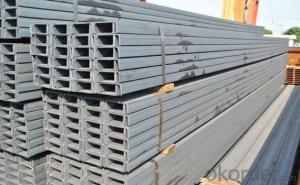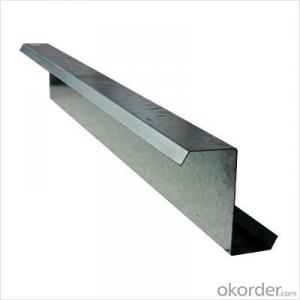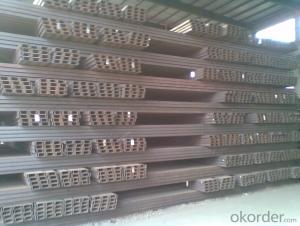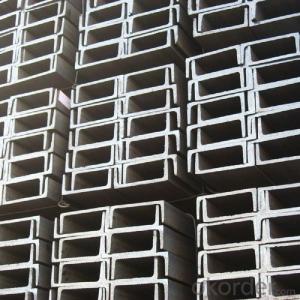Speical Used Steel U Channel With Higher Yield Point
- Loading Port:
- Tianjin
- Payment Terms:
- TT or LC
- Min Order Qty:
- 25 m.t.
- Supply Capability:
- 1000 m.t./month
OKorder Service Pledge
OKorder Financial Service
You Might Also Like
Description
In the production of steel products, steel is molded and reshaped with different machinery at different temperatures. One process is steel rolling, which involves metal stock passing through a pair of rolls. Rolling produces flat steel sheets of a specific thickness, and the process is classified according to the temperature at which the metal is rolled. If the temperature of the metal is above its recrystallization temperature, or the temperature at which the grain structure of the metal can be altered, then the process is termed as hot rolling. If the temperature of the metal is below its recrystallization temperature, the process is termed as cold rolling.
Like cold rolling, cold drawing is performed at room temperature, but instead of producing a flat object like a coke can, cold drawing makes steel into the form of a wire like the spokes of a wheel or a paper clip. To start the process, Steel is usual hammered and rolled so that it can be fit through a die; a tool that turns the steel mass into a wire. The room temperature steel is pulled through the die which reshapes it into a thinner shape while maintaining the same volume. It is similar to the idea of syrup flowing out of a bottle through a tube in that it changes shape but not volume, but instead of squeezing the metal, it is pulled out. In order to get the wire down to the right diameter, it usually requires more than one pass through different dies.
Chemical Compostion
Grade | Element(%) | |||
C | Mn | P | S | |
SS330 | -- | -- | ≦0.050 | ≦0.050 |
SS400 | ||||
SS490 | ||||
SS540 | ≦0.30 | ≦1.60 | ≦0.040 | ≦0.040 |
Usage/Applications
Channel Steel is usually used for building structure, vehicle manufacturing and other industrial structure and often used with i beam.
In details, the channel steel belongs to carbon structural steel which is applied to in the field of construction and machinery. The channel steel is usually used for arch-itechtural structure, and they could be welded in order to support or hang a vari-ety of facilities. They are also usually used in combination with I beam. Generally,the channel steel must possess perfect welding property, riveting property and mechanical property and so on.
FAQ:
Q1: Why buy Materials & Equipment from OKorder.com?
A1: All products offered byOKorder.com are carefully selected from China's most reliable manufacturing enterprises. Through its ISO certifications, OKorder.com adheres to the highest standards and a commitment to supply chain safety and customer satisfaction.
Q2: How do we guarantee the quality of our products?
A2: We have established an advanced quality management system which conducts strict quality tests at every step, from raw materials to the final product. At the same time, we provide extensive follow-up service assurances as required.
Q3: Can stainless steel rust?
A3: Stainless does not "rust" as you think of regular steel rusting with a red oxide on the surface that flakes off. If you see red rust it is probably due to some iron particles that have contaminated the surface of the stainless steel and it is these iron particles that are rusting. Look at the source of the rusting and see if you can remove it from the surface.
Q4: What makes stainless steel stainless?
A4: Stainless steel must contain at least 10.5 % chromium. It is this element that reacts with the oxygen in the air to form a complex chrome-oxide surface layer that is invisible but strong enough to prevent further oxygen from "staining" (rusting) the surface. Higher levels of chromium and the addition of other alloying elements such as nickel and molybdenum enhance this surface layer and improve the corrosion resistance of the stainless material.
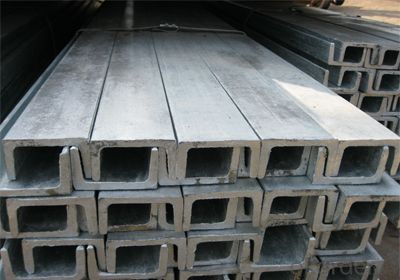

- Q:What's the name of channel steel?
- Channel steel is divided into ordinary channel steel and light channel steel.Again: according to different shapes, they can be divided into 4 kinds: cold bending equilateral channels, cold-formed non equilateral channel steel, cold rolled edge channels, the cold bending edge channels.
- Q:What are the maximum span lengths for steel channels?
- The maximum span lengths for steel channels can vary depending on the specific channel size, design factors, and load requirements. Generally, larger and more robust steel channels can span longer distances compared to smaller and lighter ones. It is advisable to consult engineering guidelines, structural codes, or a structural engineer to determine the maximum safe span lengths for specific steel channel sizes and applications.
- Q:Can steel channels be used in the construction of pedestrian bridges?
- Indeed, the utilization of steel channels is viable for the construction of pedestrian bridges. Owing to their exceptional robustness and longevity, steel channels are frequently employed as fundamental components in bridge construction. They offer the indispensable reinforcement and steadiness required for pedestrian bridges, ensuring a reliable and secure crossing. Moreover, the fabrication and installation of steel channels are straightforward, rendering them a pragmatic selection for bridge construction endeavors.
- Q:What are the different corrosion protection methods for steel channels?
- There are several corrosion protection methods available for steel channels. These include the application of protective coatings, such as paint or epoxy, which create a barrier between the steel and the corrosive environment. Galvanizing is another method, where a layer of zinc is applied to the surface of the steel to provide protection. Cathodic protection can also be used, which involves the use of a sacrificial anode or an impressed current to prevent corrosion. Additionally, proper maintenance and regular inspections can help identify and address any potential corrosion issues in steel channels.
- Q:Can steel channels be used for solar panel racking systems?
- Indeed, solar panel racking systems can make use of steel channels. These channels are frequently employed in the construction field owing to their robustness, longevity, and adaptability. They establish a solid structure for the attachment and reinforcement of solar panels, guaranteeing their secure positioning. Moreover, steel channels can be readily tailored and manufactured to meet particular project prerequisites, rendering them fitting for diverse solar panel installation designs.
- Q:Can steel channels be used in the telecommunications manufacturing industry?
- Yes, steel channels can be used in the telecommunications manufacturing industry. They are commonly used for structural support, cable management, and equipment mounting in telecommunication infrastructure. Steel channels provide strength, durability, and versatility for various telecommunications applications.
- Q:Can steel channels be used for creating support structures for communication towers?
- Yes, steel channels can be used for creating support structures for communication towers. Steel channels offer high strength and durability, making them suitable for carrying heavy loads and withstanding harsh weather conditions. Additionally, their versatile shape and design allow for easy installation and customization to meet the specific requirements of communication towers.
- Q:Can steel channels be used in the construction of soundproof walls?
- Yes, steel channels can be used in the construction of soundproof walls. Steel channels, also known as steel studs or metal studs, are commonly used in the construction industry for their strength, durability, and versatility. When constructing soundproof walls, it is important to minimize any gaps or weak points that can allow sound to penetrate through. Steel channels can provide a solid framework for the wall, ensuring a tight and secure structure that can effectively block sound transmission. In soundproof wall construction, steel channels are typically used as the framing material. They are installed vertically from floor to ceiling and horizontally between the top and bottom plates to create a sturdy framework. This framework is then filled with soundproofing materials such as insulation, mass-loaded vinyl, or acoustic panels to enhance the soundproofing properties of the wall. The rigidity and strength of steel channels make them suitable for supporting heavy soundproofing materials and ensuring the wall remains intact even under significant sound pressure. Moreover, steel channels are resistant to warping, rotting, and termites, making them a durable option for long-lasting soundproof walls. However, it is important to note that the overall effectiveness of a soundproof wall depends on various factors such as the choice of soundproofing materials, construction techniques, and proper installation. Steel channels alone may not provide complete soundproofing, as sound can still travel through other elements such as doors, windows, or ceiling. Therefore, it is essential to consider a holistic approach to soundproofing, addressing all potential weak points in the construction to achieve optimal results.
- Q:What are the common maintenance requirements for steel channels?
- To ensure the longevity and optimal performance of steel channels, regular maintenance is necessary. Here are some common maintenance tasks for steel channels: 1. Regularly clean the steel channels to remove dirt, dust, and debris. Use a mild detergent and water solution, rinse with clean water, and dry with a soft cloth. Avoid abrasive cleaners or scrub brushes that could damage the surface. 2. Check for corrosion regularly, especially in high humidity or moisture-exposed areas. Address any signs of rust or corrosion promptly. Remove surface rust with a wire brush or abrasive pad, and apply a suitable rust inhibitor or paint to prevent further corrosion. 3. Lubricate moving parts, such as sliding doors or windows, regularly to ensure smooth operation. Use lubricating oil or grease specifically designed for steel to prevent friction and wear. 4. Periodically inspect the steel channels for any damage or structural issues. Look for cracks, dents, or deformities that could compromise strength and stability. Consult a professional for repair or replacement if any issues are found. 5. Check the paintwork regularly and touch up any chipped, faded, or peeled areas. This not only enhances the appearance but also provides added protection against corrosion. 6. Ensure proper drainage systems are in place to prevent water accumulation. Standing water can cause corrosion and structural problems. Clear drains and gutters of debris to maintain proper water flow. By following these maintenance tasks, steel channels can be maintained in good condition, ensuring durability and functionality for years to come.
- Q:Can steel channels be used for catwalks?
- Yes, steel channels can be used for catwalks. Steel channels are commonly used in construction for their strength and durability. They provide a stable and secure platform for individuals to walk on, making them suitable for catwalks. Additionally, steel channels can be easily customized and fabricated to meet specific design requirements, such as length, width, and load-bearing capacity, making them versatile for various catwalk applications.
1. Manufacturer Overview |
|
|---|---|
| Location | |
| Year Established | |
| Annual Output Value | |
| Main Markets | |
| Company Certifications | |
2. Manufacturer Certificates |
|
|---|---|
| a) Certification Name | |
| Range | |
| Reference | |
| Validity Period | |
3. Manufacturer Capability |
|
|---|---|
| a)Trade Capacity | |
| Nearest Port | |
| Export Percentage | |
| No.of Employees in Trade Department | |
| Language Spoken: | |
| b)Factory Information | |
| Factory Size: | |
| No. of Production Lines | |
| Contract Manufacturing | |
| Product Price Range | |
Send your message to us
Speical Used Steel U Channel With Higher Yield Point
- Loading Port:
- Tianjin
- Payment Terms:
- TT or LC
- Min Order Qty:
- 25 m.t.
- Supply Capability:
- 1000 m.t./month
OKorder Service Pledge
OKorder Financial Service
Similar products
New products
Hot products
Hot Searches
Related keywords
